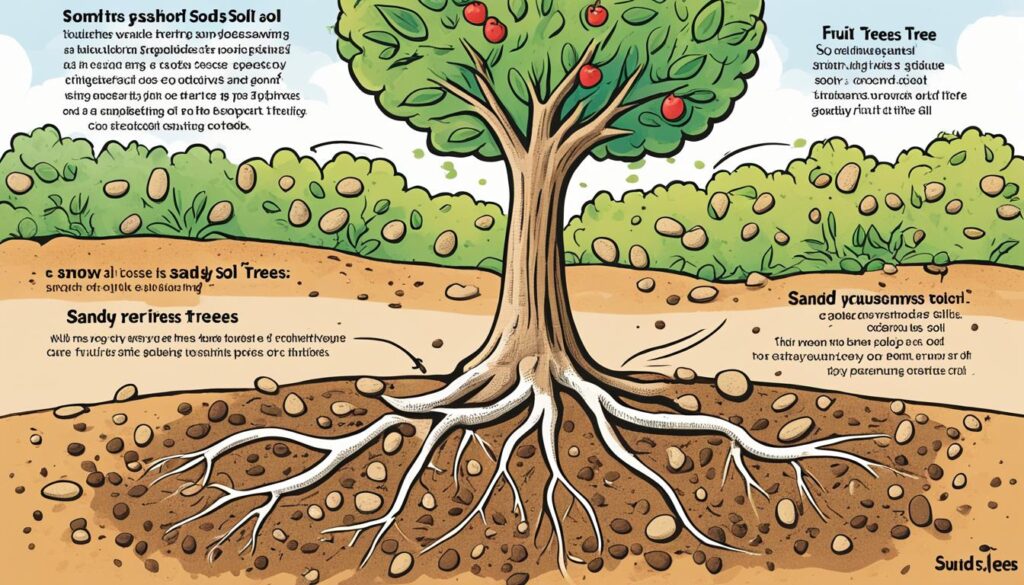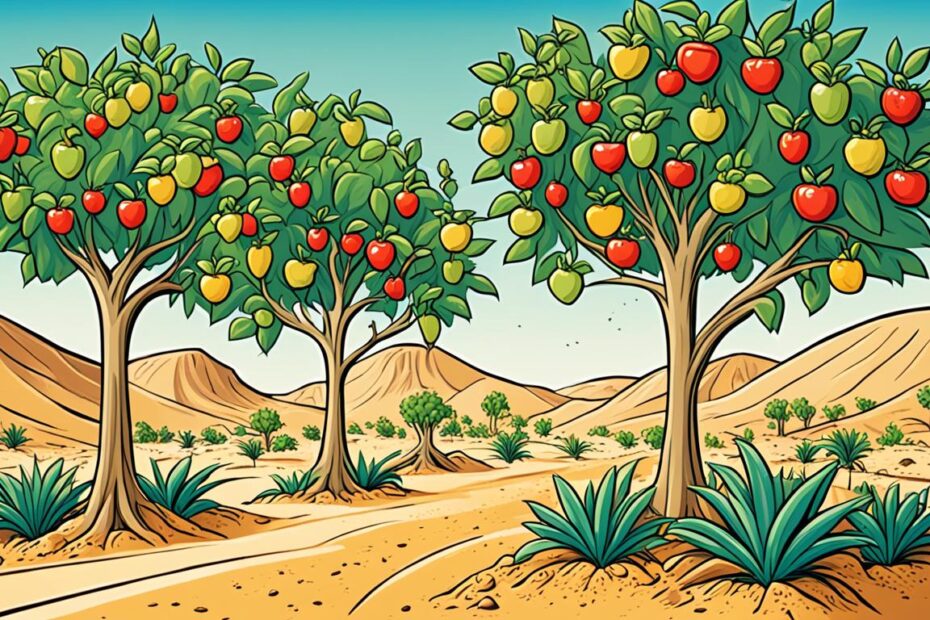Have you ever wondered if it’s possible to grow fruit trees in sandy soil? Many gardeners believe that sandy soil is a challenging environment for fruit tree cultivation, but is that really the case? Can you create a bountiful orchard in sandy soil conditions? Let’s explore the possibilities and discover the secrets to growing fruit trees that thrive in sandy soil.
Key Takeaways
- Growing fruit trees in sandy soil requires careful consideration and soil preparation.
- Factors such as soil pH, drainage, and nutrient levels play a crucial role in fruit tree cultivation.
- Certain fruit tree varieties are particularly well-suited for sandy soil conditions.
- Sandy soil has unique characteristics that impact plant growth, such as low water retention and acidic pH levels.
- Creating an optimal soil environment with soil amendments and proper maintenance is key to success.
General Considerations for Growing Fruit Trees in Sandy Soil
When it comes to growing fruit trees in sandy soil, there are several important factors to consider. By understanding these general principles, you can create an optimal environment for your fruit trees to thrive and produce a bountiful harvest.
- Maintenance: Fruit trees, like any other plants, require regular maintenance to ensure their health and productivity. This includes pruning branches, thinning out excess fruit, and monitoring for pests and diseases. By staying on top of these tasks, you can keep your fruit trees in top condition.
- Rootstock: The choice of rootstock for your fruit trees is crucial as it determines their ultimate size, disease resistance, and tolerance to different soil conditions. Selecting a rootstock that is well-suited to sandy soil will greatly enhance the chances of success for your fruit trees.
- Soil pH: The pH level of your sandy soil plays a vital role in the overall health of your fruit trees. While most fruit trees prefer a slightly acidic to neutral pH, it’s important to test your soil and make any necessary amendments to achieve the ideal pH range.
- Drainage: Sandy soil naturally has good drainage properties, which can be an advantage for fruit trees. However, it’s crucial to ensure that the soil drains well without becoming waterlogged. Proper drainage prevents root rot and other issues that can harm the health of your trees.
- Nutrient Levels: Sandy soil tends to have lower nutrient levels compared to other soil types. To compensate for this, it’s important to provide your fruit trees with adequate nutrients through regular fertilization. Testing your soil and using appropriate fertilizers will help maintain the optimal nutrient levels.
Remember, creating the right conditions for your fruit trees in sandy soil is essential for their growth and productivity. By incorporating these general considerations into your gardening practices, you’ll set yourself up for success.
Now that you understand the general principles for growing fruit trees in sandy soil, let’s explore the specific fruit tree varieties that thrive in these conditions.
Fruit Trees Suitable for Sandy Soil
| Tree Type | Soil Preference | Preferred pH Range |
|---|---|---|
| Apple | Sandy loam to loamy soils | 6.0-7.0 |
| Apricot | Loamy soils | 6.0-7.0 |
| Nectarine | Sandy soil | Slightly acidic to neutral |
| Pawpaw | Sandy loam to loamy soils | 5.5-7.0 |
| Asian Pear | Sandy loam to loamy soils | 6.0-7.0 |
| Pear | Sandy loam to loamy soils | 6.0-7.0 |
| Peach | Sandy soil | 5.8-7.0 |
| Plum | Sandy soil | 5.8-7.0 |
| Sweet Cherry | Sandy soil | 5.8-6.8 |
| Tart Cherry | Sandy soil | 5.8-6.8 |
Specific Fruit Trees for Sandy Soil
Certain fruit trees are particularly well-suited for sandy soil conditions. By selecting the right fruit trees, you can create a thriving orchard even in sandy soil. Consider the following fruit tree varieties that can successfully grow in sandy soil:
Apple Trees
Apple trees, such as Liberty and Enterprise varieties, are adaptable and can flourish in sandy loam to clay loam soils. These trees not only produce delicious fruits but also add beauty to your garden landscape.
Apricot Trees
Apricot trees thrive in loamy soils with a slightly acidic to neutral pH range of 6.0-7.0. Their vibrant blossoms and sweet fruits will bring joy to your orchard.
Nectarine Trees
Nectarine trees grow exceptionally well in sandy soil with a slightly acidic to neutral pH. These trees create a stunning visual display with their showy flowers and produce mouthwatering, juicy fruits for your enjoyment.
Other Fruit Trees
In addition to the aforementioned trees, there are several other fruit trees that can thrive in sandy soil. Consider planting pawpaw, Asian pear, pear, peach, plum, sweet cherry, and tart cherry trees in your sandy soil orchard. Each of these trees has specific soil and spacing requirements that should be taken into account for successful cultivation.
To ensure optimal growth and fruit production, it is essential to provide adequate spacing for each fruit tree. Refer to the table below for recommended fruit tree spacing:
| Fruit Tree | Spacing (in feet) |
|---|---|
| Apple Trees | 20-25 |
| Apricot Trees | 15-20 |
| Nectarine Trees | 12-16 |
| Pawpaw Trees | 15-20 |
| Asian Pear Trees | 20-25 |
| Pear Trees | 20-25 |
| Peach Trees | 12-16 |
| Plum Trees | 15-20 |
| Sweet Cherry Trees | 20-25 |
| Tart Cherry Trees | 15-20 |

With proper care and consideration for soil pH, watering, and fertilization, these fruit trees will thrive in sandy soil, providing you with an abundant harvest for years to come.
Characteristics of Sandy Soil
When it comes to growing fruit trees in sandy soil, understanding the characteristics of this soil type is essential for successful cultivation. Sandy soil has unique properties that can both benefit and challenge your fruit trees. Let’s explore the key characteristics:
1. Water Retention
Sandy soil has low water retention compared to other soil types. The sandy particles in the soil allow water to drain quickly, which can result in dry conditions for your fruit trees. To ensure your trees receive adequate hydration, regular irrigation is necessary, especially during dry periods or hot weather.
2. Soil Composition
Sandy soil is primarily composed of sand particles. These particles create a well-draining soil structure, allowing excess water to move freely through the soil profile. While good drainage is beneficial for fruit trees, it can also lead to the leaching of nutrients. Nutrients applied to sandy soil may be washed away before they can be absorbed by the tree’s roots. This means that additional fertilization and careful nutrient management are crucial for maintaining optimal nutrient levels.
3. pH Levels
Sandy soil typically has a more acidic pH level compared to other soil types. The acidity of the soil can impact nutrient availability for your fruit trees. It’s important to regularly test the pH of your sandy soil and make any necessary adjustments to ensure optimal pH levels for tree growth and nutrient uptake.
To help you visualize the characteristics of sandy soil, take a look at the image below:

Table: Comparison of Sandy Soil Characteristics
| Characteristics | Description |
|---|---|
| Water Retention | Low |
| Soil Composition | Mainly sand particles |
| pH Levels | Generally more acidic |
“Sandy soil provides excellent drainage for fruit trees, preventing waterlogging and the associated root rot. However, it’s crucial to address its low water retention and nutrient leaching properties through proper irrigation and nutrient management.” – Expert Gardener
By understanding the unique characteristics of sandy soil, you can make informed decisions regarding soil amendment, irrigation, and nutrient management. In the next section, we will explore how to create an optimal soil environment for fruit trees in sandy soil.
Creating an Optimal Soil Environment for Fruit Trees in Sandy Soil
To grow thriving fruit trees in sandy soil, it is crucial to create an optimal soil environment. By taking the following steps, you can ensure that your fruit trees receive the necessary nutrients and water retention they need to flourish.
- Mix organic matter with native soil: Improve water retention and provide essential nutrients by mixing organic matter such as compost, peat moss, and perlite with the native sandy soil. This amendment helps create a more favorable growing environment for fruit trees.
- Add smaller amounts of compost frequently: Sandy soil tends to drain quickly, so it is beneficial to add smaller amounts of compost more frequently. This practice ensures a steady supply of nutrients for the fruit trees, promoting healthy growth and development.
- Consider soil amendment with lime: Sandy soil tends to be more acidic, which may affect the pH levels necessary for optimal fruit tree growth. Soil amendment with lime can help balance the acidity levels, creating a more favorable soil environment.
- Regularly monitor pH levels: Keeping a close eye on the pH levels of sandy soil is essential for maintaining an optimal soil environment. Fruit trees thrive in slightly acidic to neutral pH levels, so regular monitoring and adjustments can support their overall health.
- Properly fertilize the soil: Regular fertilization is crucial for fruit trees in sandy soil. Choose fertilizers specifically formulated for fruit trees and follow the recommended application rates. This practice ensures that the trees receive the necessary nutrients to flourish.
Creating an optimal soil environment for fruit trees in sandy soil takes effort, but the results are worth it. By providing the right mixture of organic matter, proper pH levels, and adequate nutrition, you can set the stage for a fruitful and thriving orchard.
Conclusion
Successful cultivation of fruit trees in sandy soil requires careful soil preparation and a focus on creating an optimal soil environment. By considering factors such as soil pH, drainage, and nutrient levels, you can ensure that your fruit trees have the best conditions to thrive.
Choosing fruit tree varieties that are well-adapted to sandy soil conditions is essential. Varieties such as Liberty and Enterprise apple trees, apricot trees, and nectarine trees are among those that can flourish in sandy soils.
Creating an optimal soil environment for your fruit trees involves adding organic matter, such as compost and peat moss, to improve water retention and provide essential nutrients. Regular monitoring of pH levels and proper fertilization are also important for maintaining a healthy soil environment.
With proper care and attention, you can enjoy the beauty and bounty of a thriving orchard of fruit trees in your sandy soil. Follow these guidelines to create the optimal conditions for successful fruit tree cultivation and watch as your orchard flourishes.
FAQ
What are the general considerations for growing fruit trees in sandy soil?
When growing fruit trees in sandy soil, it is important to consider factors such as soil pH, drainage, nutrient levels, annual maintenance, pruning, fruit thinning, choosing the right rootstock, pesticide applications, full sun, well-drained sandy loam to loamy soils, and proper spacing of trees.
Which specific fruit trees are suitable for sandy soil?
Specific fruit trees that can thrive in sandy soil conditions include apple trees (varieties like Liberty and Enterprise), apricot trees (prefer loamy soils with a pH range of 6.0-7.0), nectarine trees (grow well in sandy soil with a slightly acidic to neutral pH), pawpaw, Asian pear, pear, peach, plum, sweet cherry, and tart cherry. Each of these trees has specific soil and spacing requirements to ensure successful cultivation.
What are the characteristics of sandy soil that impact fruit tree growth?
Sandy soil has low water retention, good drainage, excessive nutrient leaching, and generally acidic pH levels. These characteristics need to be considered for proper soil amendment and maintenance to create an optimal soil environment for fruit trees in sandy soil.
How can I create an optimal soil environment for fruit trees in sandy soil?
To create an optimal soil environment, you can mix organic matter like compost, peat moss, and perlite with the native sandy soil to improve water retention and provide essential nutrients. Adding smaller amounts of compost more frequently is recommended. Soil amendment with lime may be necessary to balance acidity levels. Regular monitoring of pH levels and proper fertilization are crucial for maintaining a healthy soil environment for fruit trees in sandy soil.
Is it possible to grow fruit trees in sandy soil?
Yes, it is possible to grow fruit trees in sandy soil with proper soil preparation and care. By considering factors such as soil pH, drainage, nutrient levels, and selecting fruit tree varieties adapted to sandy soil conditions, you can create an optimal environment for fruit trees to thrive and enjoy a bountiful orchard.
